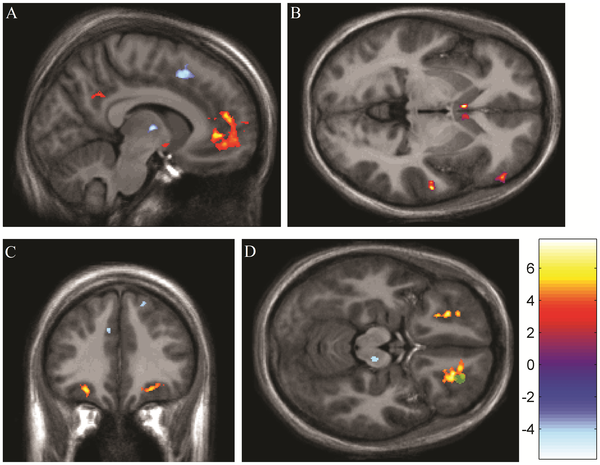That's not to say you should rely on a string of affairs when you have a headache, but a better understanding of these neural-rewards pathways that get triggered by 'love', or winning money, could lead to new methods for producing pain relief.
The concept for the study was sparked several years ago at a neuroscience conference when Arthur Aron, PhD, a professor of psychology at State University of New York at Stony Brook and an expert in the study of love, met up with Sean Mackey, MD, PhD, chief of the Division of Pain Management, associate professor of anesthesia and senior author of the study, and they began talking.
"Art was talking about love," Mackey said. "I was talking about pain. He was talking about the brain systems involved with love. I was talking about the brain systems involved with pain. We realized there was this tremendous overlapping system. We started wondering, 'Is it possible that the two modulate each other?'"
After the conference, Mackey returned to Stanford and collaborated with postdoctoral scholar Jarred Younger, PhD, now an assistant professor of anesthesia, who was also intrigued with the idea. Together the three set up a study that would entail examining the brain images of undergraduates who claimed to be "in that first phase of intense love."
"We posted fliers around Stanford University and within hours we had undergrads banging on our door," Mackey said. The fliers asked for couples who were in the first nine months of a romantic relationship.
"It was clearly the easiest study the pain center at Stanford has ever recruited for," Mackey said. "When you're in love you want to tell everybody about it. "We intentionally focused on this early phase of passionate love. We specifically were not looking for longer-lasting, more mature phases of the relationship. We wanted subjects who were feeling euphoric, energetic, obsessively thinking about their beloved, craving their presence.
"When passionate love is described like this, it in some ways sounds like an addiction. We thought, 'Maybe this does involve similar brain systems as those involved in addictions which are heavily dopamine-related.' Dopamine is the neurotransmitter in our brain that is intimately involved with feeling good."
Researchers recruited 15 undergraduates (eight women and seven men) for the study. Each was asked to bring in photos of their beloved and photos of an equally attractive acquaintance. The researchers then successively flashed the pictures before the subjects, while heating up a computer-controlled thermal stimulator placed in the palm of their hand to cause mild pain. At the same time, their brains were scanned in a functional magnetic resonance imaging machine.
The undergraduates were also tested for levels of pain relief while being distracted with word-association tasks such as: "Think of sports that don't involve balls." Scientific evidence has shown in the past that distraction causes pain relief, and researchers wanted to make sure that love was not just working as a distraction from pain.
Results showed that both love and distraction did equally reduce pain, and at much higher levels than by concentrating on the photo of the attractive acquaintance, but interestingly the two methods of pain reduction used very different brain pathways.

Neural responses associated with viewing pictures of a beloved during periods of acute experimental thermal pain. Significant clusters are shown on an MNI-normalized average of all participants' high-resolution structural scans. Neurological (right on right) convention is used. (a) Sagittal view (x = −8) of conjunction analyses showing areas of BOLD increase (yellow) and decrease (blue) associated with viewing pictures of a romantic partner, over and above both viewing pictures of an attractive and familiar acquaintance, and a word-association distraction task. Activations (anterior to posterior) include the medial orbitofrontal cortex, pregenual anterior cingulate cortex, amygdala, and precuneus. Deactivations are seen in the supplementary motor area and ventral lateral nucleus of the thalamus. (b) Axial view (z = −3) of neural activation associated with pain relief during viewing of romantic partner pictures. Greater pain relief was associated with greater activity in the right dorsolateral prefrontal cortex, bilateral caudate head, and right superior temporal gyrus. (c) Coronal view (y = 34) of neural activity increase (yellow) and decrease (blue) associated with pain relief during viewing the romantic partner pictures. Pain relief is associated with greater BOLD activity in the bilateral lateral orbitofrontal cortices, and decreased BOLD activity in the left dorsal anterior cingulate cortex and right supplementary motor area. (d) Axial view (z = −16) of neural activity increase (yellow) and decrease (blue) associated with pain relief during viewing the romantic partner pictures. Pain relief is associated with greater BOLD activity in the bilateral lateral orbitofrontal cortices, and decreased activity in the right brainstem, approximately in the location of the substantia nigra. Also shown (in green) is an overlapping area of the right lateral orbitofrontal cortex that was also positively associated with analgesia in the distraction condition. Credit: doi:10.1371/journal.pone.0013309.g001, see citation below
"With the distraction test, the brain pathways leading to pain relief were mostly cognitive," Younger said. "The reduction of pain was associated with higher, cortical parts of the brain. Love-induced analgesia is much more associated with the reward centers. It appears to involve more primitive aspects of the brain, activating deep structures that may block pain at a spinal level — similar to how opioid analgesics work.
"One of the key sites for love-induced analgesia is the nucleus accumbens, a key reward addiction center for opioids, cocaine and other drugs of abuse. The region tells the brain that you really need to keep doing this," Younger said.
"This tells us that you don't have to just rely on drugs for pain relief," Aron said. "People are feeling intense rewards without the side effects of drugs."
Citation: Citation: Younger J, Aron A, Parke S, Chatterjee N, Mackey S, 'Viewing Pictures of a Romantic Partner Reduces Experimental Pain: Involvement of Neural Reward Systems', PLoS ONE 5(10): e13309. doi:10.1371/journal.pone.0013309





Comments